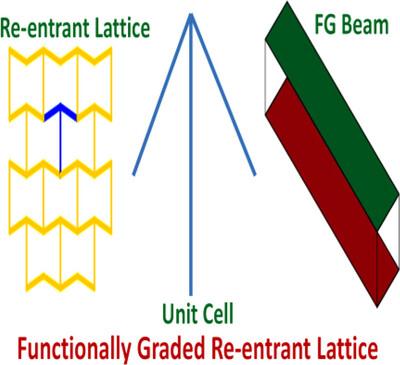基于动态刚度法和Wittrick-Williams算法的功能梯度重入点阵结构中的波传播
IF 2.9
4区 工程技术
Q1 MULTIDISCIPLINARY SCIENCES
引用次数: 0
摘要
功能梯度材料(fgm)增强了均匀材料的机械性能,而结构周期结构使轻量化设计具有优越的性能。本研究结合功能梯度重入晶格(FG-RL)结构的优点,研究了波在功能梯度重入晶格(FG-RL)结构中的传播。单元格由三个由fgm制成的Timoshenko梁单元组成,根据幂律,指数和三角渐变轮廓,结合轴向变形材料特性随厚度而变化。采用动力刚度法(DSM)结合Floquet-Bloch定理进行波传播分析,并通过Wittrick-Williams算法求解得到的特征值问题。探讨了两种建模方法:为所有光束分配相同的幂律指标和对每个光束使用不同的指标。结果表明,在不改变色散曲线整体形状的情况下,幂律指数的增加降低了波速并改变了频率范围。此外,单晶胞内的材料非均质性引入了带隙。通过与FEM和COMSOL Multiphysics结果的比较,验证了该方法的准确性。这项工作突出了fgm在调谐波传播行为方面的有效性,并为具有可定制动态特性的先进晶格结构的设计提供了可靠的框架。本文章由计算机程序翻译,如有差异,请以英文原文为准。

Wave Propagation in Functionally Graded Re-Entrant Lattice Structures Using the Dynamic Stiffness Method and Wittrick–Williams Algorithm
Functionally graded materials (FGMs) enhance the mechanical performance of homogeneous materials, while architected periodic structures enable lightweight designs with superior properties. This study investigates wave propagation in functionally graded re-entrant lattice (FG-RL) structures, combining the advantages of FGMs and architected lattices. The unit cell comprises three Timoshenko beam elements made of FGMs, incorporating axial deformation material properties varying through the thickness according to power-law, exponential, and trigonometric gradation profiles. Wave propagation analysis is carried out using the dynamic stiffness method (DSM) coupled with the Floquet–Bloch theorem, and the resulting eigenvalue problem is solved via the Wittrick–Williams algorithm. Two modeling approaches are explored: assigning identical power-law indices to all beams, and using different indices for each beam. Results reveal that increasing the power-law index reduces wave speed and shifts the frequency range without altering the overall shape of the dispersion curves. Additionally, material heterogeneity within the unit cell introduces bandgaps. The accuracy of the proposed method is validated through comparisons with FEM and COMSOL Multiphysics results. This work highlights the effectiveness of FGMs in tuning wave propagation behavior and offers a reliable framework for the design of advanced lattice structures with customizable dynamic characteristics.
求助全文
通过发布文献求助,成功后即可免费获取论文全文。
去求助
来源期刊

Advanced Theory and Simulations
Multidisciplinary-Multidisciplinary
CiteScore
5.50
自引率
3.00%
发文量
221
期刊介绍:
Advanced Theory and Simulations is an interdisciplinary, international, English-language journal that publishes high-quality scientific results focusing on the development and application of theoretical methods, modeling and simulation approaches in all natural science and medicine areas, including:
materials, chemistry, condensed matter physics
engineering, energy
life science, biology, medicine
atmospheric/environmental science, climate science
planetary science, astronomy, cosmology
method development, numerical methods, statistics
 求助内容:
求助内容: 应助结果提醒方式:
应助结果提醒方式:


